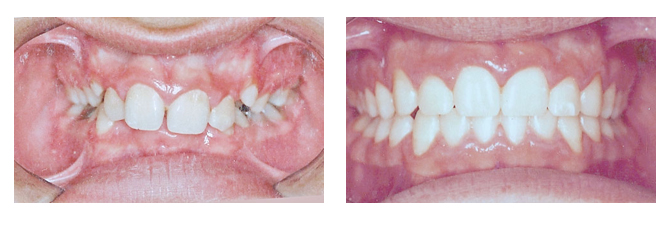We can help you Achieve a Brighter Smile!
|
1. In addition to crowding this patient had narrow arch width and posterior crossbites. Speech and adequate oral hygiene were impaired. Braces for a period of 24 months and a maxillary expander were used to correct these problems. Jaw size was adequate and no teeth were extracted. This patient now has a better smile and a balanced occlusion with improved speech and self-esteem.
2. This patient had a deep overbite as well as an uneven smile due to oblique tipping of the upper incisors. The lower anterior teeth were impinging against the palate behind the upper incisors. Braces and a maxillary bite plate were used to correct these problems over a 24-month period. The patient now has a symmetrical smile and a balanced occlusion. 3. This patient had a speech impediment and an anterior open bite due to a tongue thrust swallowing pattern and a thumb sucking habit. Braces along with myofunctional therapy were used to correct these problems. 4. This patient had a crowding and overbite problem that was corrected with braces. Treatment was completed in two phases – interceptive orthodontic care for a few months at age 8 and comprehensive treatment once all the permanent teeth had erupted at age 12. 5. This patient had an anterior crossbite (underbite) with incisor spacing. These problems were corrected with braces and elastics. 6. This is a profile view of the same patient. Braces and elastics were used to move the upper incisors anteriorly and the lower incisors posteriorly. 7. Braces and a maxillary expansion appliance were used to correct narrow arch width and a posterior crossbite. The patient now has a more comfortable bite and a balanced occlusion. Risk of excessive and uneven tooth wear has been reduced. 8. Crowding increases the risk of cavities and bone loss. This patient had braces to correct the crowding, reducing the risk of cavities and loss of bone support around the teeth. This resulted in a healthy balanced occlusion and a more pleasing smile, while making tooth brushing and flossing much easier. 9. Crowding was making adequate brushing and flossing the teeth challenging. The lack of contact of the anterior teeth also made chewing more difficult. Excessive wear on the posterior teeth was becoming evident. Braces were used to correct these problems establishing a balanced occlusion, a better smile and improved oral hygiene. It was not necessary to extract any teeth. 10. and 11. Crowding and crossbites increase the risk of gum disease, tooth decay and chewing difficulties. Orthodontic treatment using braces corrected these problems, decreasing the risk of tooth decay and gum disease by making it easier to brush and floss in addition to establishing a healthy balanced occlusion and pleasing smile. |
















